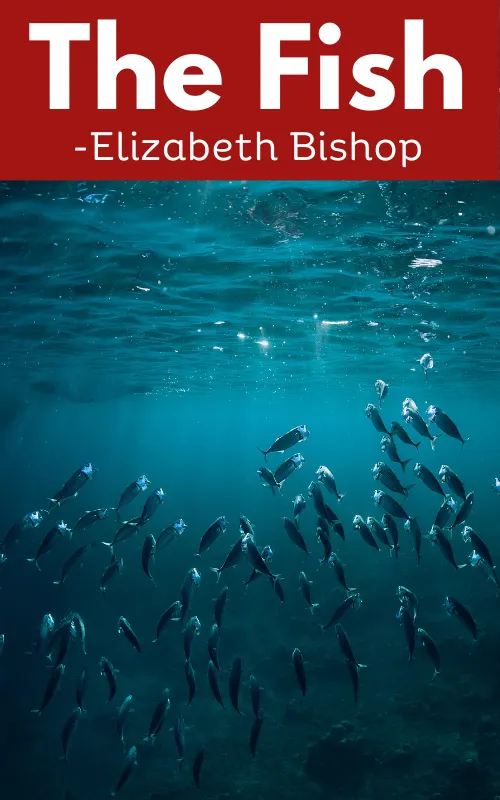About the Poem “The Fish“
| Poem Title | The Fish |
| Author | Elizabeth Bishop |
| Publication year | 1946 |
| Form | Free verse |
| Speaker | A person who has caught a fish |
| Setting | A boat on the water |
| Subject | The speaker’s observations of a fish they have caught |
| Themes | Nature, beauty, empathy, mortality |
| Literary devices | Simile, personification, enjambment, imagery |
Themes of The Fish
The themes of poem “The Fish” by Elizabeth Bishop are:
- Appreciating Imperfection ➤ The poem celebrates the beauty of imperfection in nature, symbolized by the fish’s scars and wounds.
- Observing Nature ➤ It highlights the act of closely observing and connecting with the natural world.
- Time and Transformation ➤ The poem explores how time changes and transforms both the fish and the speaker’s perception of it.
- Resilience ➤ It portrays the fish as a symbol of resilience, surviving despite its injuries.
- Connection to Nature ➤ The speaker’s emotional journey reflects the human connection to nature and the sense of wonder it can evoke.
“The Fish” Poem by Elizabeth Bishop
I caught a tremendous fish
and held him beside the boat
half out of water, with my hook
fast in a corner of his mouth.
He didn’t fight.
He hadn’t fought at all.
He hung a grunting weight,
battered and venerable
and homely. Here and there
his brown skin hung in strips
like ancient wallpaper,
and its pattern of darker brown
was like wallpaper:
shapes like full-blown roses
stained and lost through age.
He was speckled with barnacles,
fine rosettes of lime,
and infested
with tiny white sea-lice,
and underneath two or three
rags of green weed hung down.
While his gills were breathing in
the terrible oxygen
—the frightening gills,
fresh and crisp with blood,
that can cut so badly—
I thought of the coarse white flesh
packed in like feathers,
the big bones and the little bones,
the dramatic reds and blacks
of his shiny entrails,
and the pink swim-bladder
like a big peony.
I looked into his eyes
which were far larger than mine
but shallower, and yellowed,
the irises backed and packed
with tarnished tinfoil
seen through the lenses
of old scratched isinglass.
They shifted a little, but not
to return my stare.
—It was more like the tipping
of an object toward the light.
I admired his sullen face,
the mechanism of his jaw,
and then I saw
that from his lower lip
—if you could call it a lip—
grim, wet, and weaponlike,
hung five old pieces of fish-line,
or four and a wire leader
with the swivel still attached,
with all their five big hooks
grown firmly in his mouth.
A green line, frayed at the end
where he broke it, two heavier lines,
and a fine black thread
still crimped from the strain and snap
when it broke and he got away.
Like medals with their ribbons
frayed and wavering,
a five-haired beard of wisdom
trailing from his aching jaw.
I stared and stared
and victory filled up
the little rented boat,
from the pool of bilge
where oil had spread a rainbow
around the rusted engine
to the bailer rusted orange,
the sun-cracked thwarts,
the oarlocks on their strings,
the gunnels—until everything
was rainbow, rainbow, rainbow!
And I let the fish go.
The Fish Summary & Analysis
Elizabeth Bishop’s poem “The Fish” is a meditation on the resilience of nature and the importance of respecting all living creatures. The poem begins with the speaker recounting their experience catching a large, old fish. After examining the fish closely, the speaker releases it back into the water.
Stanza 1
The speaker opens the poem by telling us that they caught a “tremendous fish.” They use the word “tremendous” to emphasize the size and strength of the fish, as well as the effort it took to catch it. The speaker goes on to describe the fish as “battered and venerable,” and “homely.” These words suggest that the fish is old, experienced, and not particularly attractive.
Stanza 2
The speaker continues to describe the fish’s physical appearance, noting its “moth-eaten” skin and its “eyes / Like jewels without their settings.” The speaker also compares the fish to a “saint” and a “war-god,” suggesting that they see the fish as a wise and powerful creature.
Stanza 3
The speaker in this stanza reflects on the fish’s life and struggles. They imagine the fish’s many encounters with other predators and the scars that it has accumulated. The speaker also notes the fish’s “hook-and-line mark” and the “swivels” and “traces” that are still attached to its mouth. These details suggest that the fish has been caught and released before, and that it has survived many challenges.
Stanza 4
In this stanza, the speaker addresses the fish directly, speaking to it as if it were a human being. The speaker tells the fish that they are “glad I did not catch you” and that they “let you go again.” The speaker also says that they are “sorry” for the pain that they have caused the fish. These lines suggest that the speaker has come to respect and admire the fish, and that they regret having tried to catch it.
Stanza 5
The speaker continues to reflect on the fish and its life. They imagine the fish swimming away into the ocean, free and independent. The speaker also imagines the fish’s “heavy body” and its “armored head,” suggesting that the fish is a powerful and resilient creature.
Stanza 6
In this stanza, the speaker compares the fish to a “submarine” and a “king.” These comparisons suggest that the speaker sees the fish as a majestic and powerful creature. The speaker also notes the fish’s “wise old eyes,” suggesting that the fish is a wise and experienced creature.
Stanza 7
The speaker continues to compare the fish to other creatures, including a “grandfather” and a “friend.” These comparisons suggest that the speaker has developed a deep affection for the fish. The speaker also says that the fish is “beautiful,” even though they had previously described it as “homely.” This suggests that the speaker has come to see the fish’s inner beauty.
Stanza 8
In the final stanza of the poem, the speaker reflects on the experience of catching and releasing the fish. They say that the fish has “taught me a lesson.” This lesson is not explicitly stated, but it seems to be a lesson about the importance of respect for all creatures, even those that are different from us.
FAQs from The Fish
What is the poem about?
The poem is about a speaker who catches a large, old fish. After examining the fish closely, the speaker releases it back into the water.
What are some of the physical characteristics of the fish?
The fish is described as “battered,” “venerable,” and “homely.” It has “old wallpaper” skin and “five old pieces of fishing line” in its mouth.
What is the speaker’s initial reaction to the fish?
The speaker is initially impressed by the size and age of the fish. They also feel a sense of victory at having caught such a creature.
What does the speaker notice about the fish’s insides?
The speaker notices that the fish has “white flesh” that is “packed in like feathers.” They also notice that the fish has swallowed five fishing hooks.
What does the speaker’s realization about the fish’s insides lead to?
The speaker’s realization about the fish’s insides leads to a sense of empathy and compassion. They begin to see the fish as a living creature with its own suffering.
Why does the speaker decide to release the fish?
The speaker decides to release the fish because they feel a sense of respect for its resilience and survival instinct. They also recognize that the fish has a right to its own life.
What is the message of poem The Fish?
The poem’s message is about the importance of respecting and protecting nature. It also teaches us that all living creatures have a right to life, even those that are different from us.
What is the significance of the rainbow at the end of the poem?
The rainbow at the end of the poem symbolizes the speaker’s transformation. After releasing the fish, the speaker sees the world in a new light. They have a greater appreciation for nature and all living creatures.











